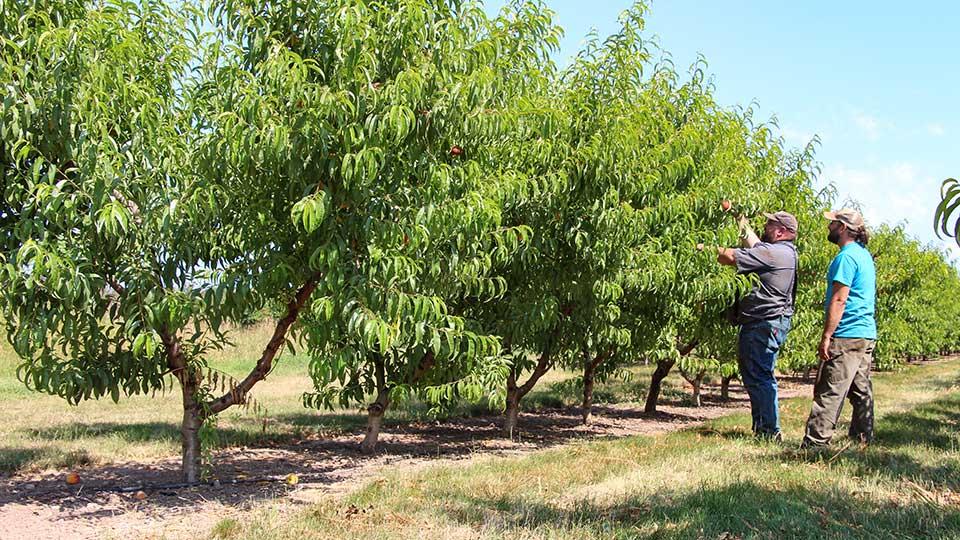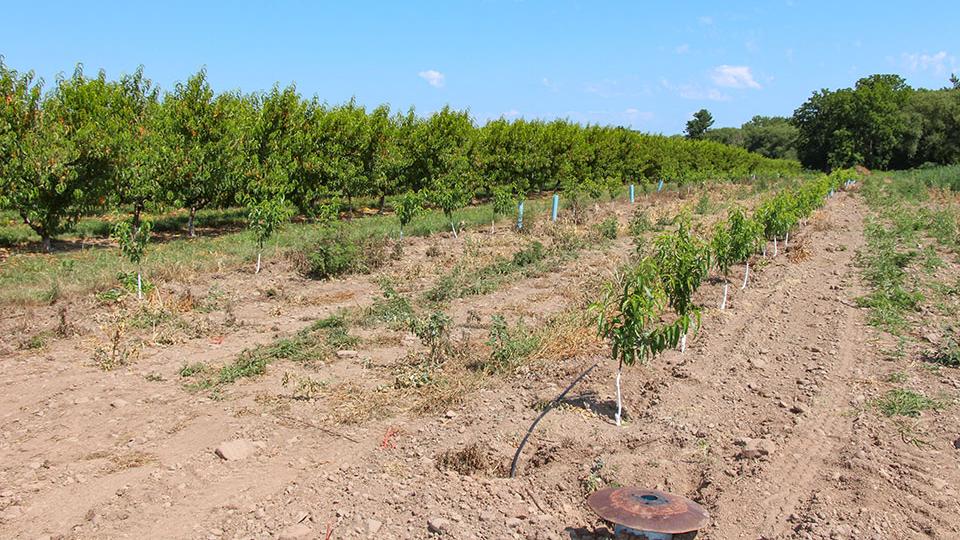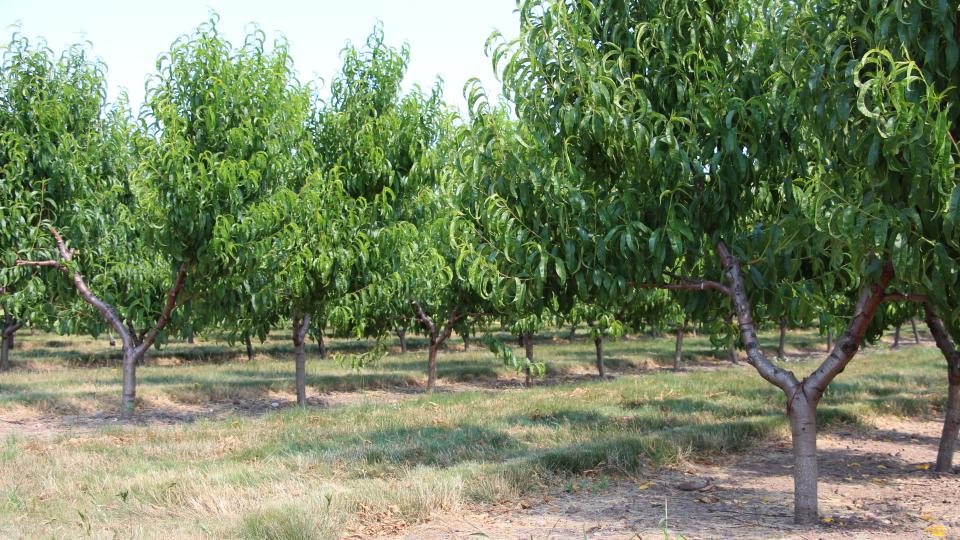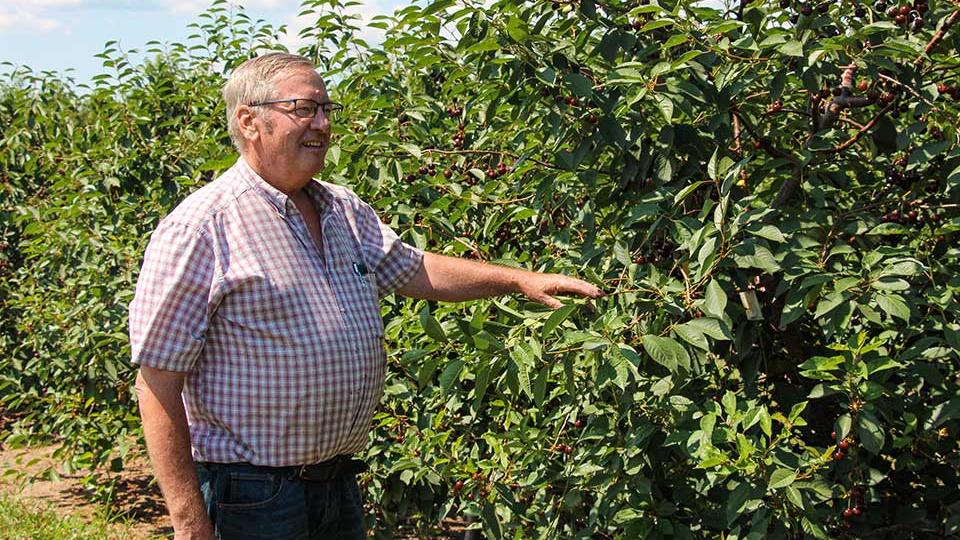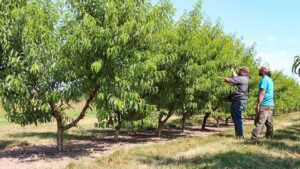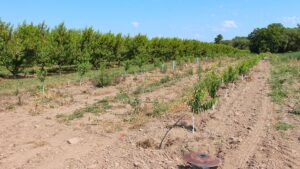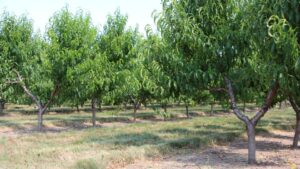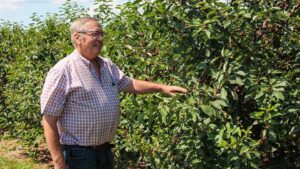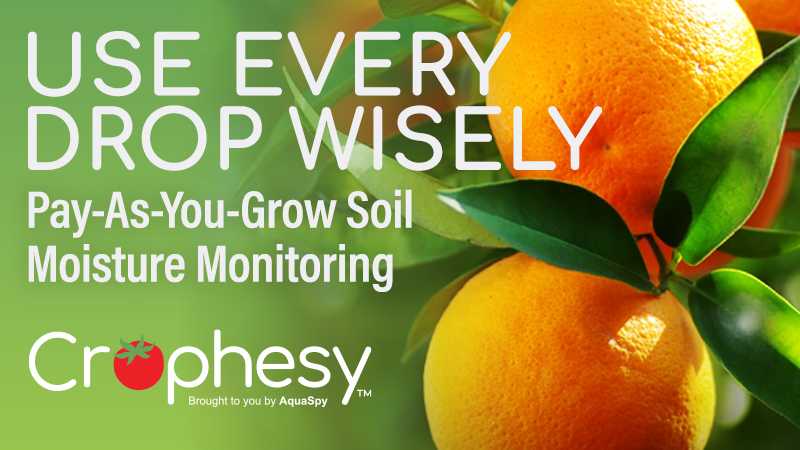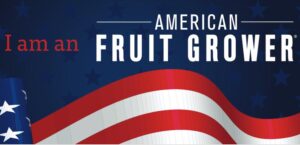How Bittner-Singer Orchards Bucks Tradition With Its Peach Plantings
Give the Bittner family a fruit tree — any type of fruit tree — and the namesakes of Bittner-Singer Orchards, on the coast of Lake Ontario in Western New York, will grow it in a high-density planting system. Sometimes even by accident.
Fifteen years ago, when their farm still catered to the processed peach market, the Bittners ordered a shipment of ‘Vulcan’ peach trees. Unbeknownst to them, the nursery instead delivered ‘Vulcan’ apricots.
“I kept saying, ‘They don’t look like peach trees. They look like plum trees or apricot trees,’” Kevin Bittner says.
Nonetheless, Kevin and his younger brother, David, took the misdirected plantings and, still believing they were peach trees, tightly spaced them in a high-density system. The result?
“It was a jungle,” Kevin says.
“Apricots,” David adds, “grow a little too quick.”
Since that time, not much has gone astray at Bittner-Singer Orchards. High-density systems comprise much of the 400-acre farm in Appleton, NY. And there is nothing accidental about it.
“The only thing we don’t do high density is tart cherries. They are machine harvested,” David Bittner says. “Everything else — sweet cherries, peaches, apples — are all high density.”
‘V’ FOR VICTORY
The Bittners’ father, Jim, has operated the 117-year-old farm since partnering with the Singer family in 1991. Kevin, 40, is the Orchard Specialist; David, 36, the Field Manager. Together, they tend to 55 acres of high-density peach, 50 acres of high-density tall-spindle apple, and 45 acres of high-density sweet cherry.
Their penchant for high-density planting systems can be traced to the orchard’s proximity — between three- and five-hour drives — to three hallowed tree fruit research centers: Cornell University, Penn State University, and Michigan State University.
“We’ve worked closely with Cornell University, especially with apples. Dr. Terence Robinson has been pushing high-density apples,” Kevin says. “And there’s Penn State and a few other places that have been pushing for high-density peaches. It made sense to us, so we tried it.”
And they’ve liked it. Especially the high-density peaches. The farm at one time boasted more than 120 varieties of high-density peach. It currently grows 55. Dr. Bob Anderson, the now-retired stone fruit breeder from Cornell, supplied most of those varieties.
In turn, the Bittners have adhered to a two-branch perpendicular V system, which, according to the University of California’s Kearney Research and Extension Center, can increase fruit yield bearing in years 2 to 6 by 15% to 125% relative to the standard open-center peach tree.
“We started the perpendicular V peaches in the late ‘90s,” Kevin says. “They were at a slightly wider spacing than the current ones — 18 by 8 feet. The next plantings we went 18 by 6, and we’ve stayed there since.”
“We like it,” David says of the perpendicular V. “It keeps it simpler for the guys to remember how to prune it. You should be able to get two nice branches, whereas, with the quad V, are you going to guarantee your tree will get four branches on every single tree? Probably not.”
Meanwhile, if the Bittners lose a tree in the perpendicular V system, they do not lose huge volume, David says.
“With these being peaches, if I lose the second tree in, I might leave the smaller branch (on an adjacent tree) and let it grow out. You won’t fill in the space completely again, but with the older open-vase system or quad Vs, if you lose a tree, you’ve lost a spot,” David says.
The Bittners also utilize a pedestrian system, keeping the trees short enough to work on from the ground, the reason being two-fold. For one, “there will never be a ladder in here,” Kevin says. “It’s all groundwork.”
Secondly, Bittner-Singer Orchards is much farther north than most U.S. peach growers, leading to differing light intensities.
“We have less light here, and all the peach buds down here need to have light to set,” Kevin adds, pointing to the bottom 4 feet of a tree. “If we have a lot taller tree, down here we’ll have nothing.”
Although other high-density peach growers have been present in the region, they have largely used taller V systems that necessitate platforms or ladders.
“You can get a slightly higher yield their way, but we feel the time spent climbing ladders or investing in platforms makes it a wash,” Kevin says. “The difference might be one or two more tons per acre.”
The taller V growers also wind up having to tie together pairs of Vs with straps to prevent splitting. “If you put trellising on peaches, that’s a canker site,” David says. “It’s going to be. Period.”
ROOTSTOCK ISSUE
High-density apple orchards require trees to be propagated on dwarfing rootstocks. Another reason the aforementioned apricot trees had failed the Bittners in the high-density scenario years ago was because there was no such thing as dwarf apricot rootstocks.
Today much the same can still be said about availability of commercial dwarf peach rootstock, David Bittner says. “There are some that they are playing with, but not really. It’s not like apples, where you have 50 rootstocks you can choose from,” he says.
“There are some rootstocks that are slightly lower vigor but are not widely used yet,” Kevin Bittner adds. “We’ve shied away from them, mostly due to availability.”
The Bittners have not only gotten by but also excelled while primarily using ‘Bailey’ and ‘Lovell’ as their rootstocks.
“In our climate they’re just vigorous enough to keep our trees going, but they’re not so vigorous that we can’t plant high density,” Kevin says. “Those are our two main rootstocks because that’s what’s primarily available.”
The Bittners purchase most of their peach trees and rootstocks from Adams County Nursery, 300 miles away in Aspers, PA.
Having overcome the rootstock dilemma, the Bittners are content with their high-density peach plantings. One of two drawbacks is the initial cost of planting so many trees, although that scenario is not as prohibitive as with apples, Kevin says.
“Planting an acre of peaches, there’s a lot less cost than an acre of apples because it is a lower density than the high-density apples and also there is no trellis,” Kevin says. “But I feel that getting the high yields in the early years and giving us a full production by the fourth year is a huge benefit to us because open land, it’s not worth it. You still take care of that orchard but have to wait two or three more years before yield.”
A second possible shortcoming of the V system is smaller fruit if proper care is lacking.
“They need more intense pruning, thinning, and irrigation to keep fruit size up,” Kevin says. “This is most likely why some stay with wider spacings.”
Fellow growers interested in high-density peach planting systems should not be discouraged by what is or is not occurring across the country, Kevin says.
“I really don’t have any answers to why someone would stick to more moderate density,” Kevin says. “It’s a different mindset to take care of higher density. It just makes sense to us, so we work with it. We’ve developed a formula. It seems to work for us, and we’ve stuck with it.”
High-Density Peach Input from Elsewhere in the U.S.
While the Bittner family has been successfully growing high-density peaches in Western New York, opinions on the topic vary in the Southeast and in California:
Dario Chavez, Associate Horticulture Professor, University of Georgia (and new peach columnist for American Fruit Grower® magazine):
“Still, the issue of lack of (rootstock) availability is a problem from the nursery side. I think we’re kind of in the stage that apples were when they started getting all of these dwarfing rootstocks, and nurseries basically were kind of apprehensive about, ‘Do I get in fully?’ ‘Can we accommodate a production system to a clonally propagated apple and the amount of investment that we would have to do to produce that many plants?’ At this point, if growers could get thousands of plants on MP29, probably they would. But to be able to order and purchase a plant, you have to have an almost two- or three-year cycle. If I wanted to plant something two years from now, I need to order it now. We have done some research trying to improve the nursery production side of things. We can actually grow a plant in a one-year cycle using tissue culture plants. But that is in a potted system and is a little bit different to what is done in the nursery system. But we were able to basically produce what we need for research, so that’s why we have been able to kind of keep going with the research on these dwarfing rootstocks. So, in summary, we don’t have a lot of exciting things in high-density training systems. We will love to have some, and we’re looking forward to basically do a little more of that work and, hopefully, you know, in 10 years we can say we have something functional with the varieties that we have right now and with the rootstocks that we have available.”
Cliff Beumel, President, Agromillora (Nursery) California:
“In California it’s been few and far between the adoption or even the investigation of high-density systems for peaches. I’m way past [trying to change] that. I don’t care about that. They’re just customers, and you can’t tell them anything. They do whatever they want. You offer plants. If they want data, that’s fine. Certainly, if somebody wants to try it, we’ll make them some trees, but you’re not going to convince these guys, ‘Hey, I’ll take you to Europe, and you can see the orchards over there, and then let’s do a trial.’ Yeah, we did that years ago. … I don’t see the California food industry as progressive at all. At all. Compared to what I see in Europe, compared to what I see in Australia, compared to what I see in South America, compared to what I see in the apple industry across the U.S. and in Washington, as well as in their cherry industry. And this is true of cherries, too, in California. The cherry industry is far more progressive pretty much everywhere else on the planet than in California. It’s an embarrassment of riches: great soil, we used to have a lot of water, lots of cheap labor, and being early-market because we’re in the Mediterranean climate. So, yeah, we’re not very progressive, we’re just very powerful.”





